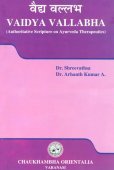Vyamishra, Vyāmiśra: 10 definitions
Introduction:
Vyamishra means something in Hinduism, Sanskrit. If you want to know the exact meaning, history, etymology or English translation of this term then check out the descriptions on this page. Add your comment or reference to a book if you want to contribute to this summary article.
The Sanskrit term Vyāmiśra can be transliterated into English as Vyamisra or Vyamishra, using the IAST transliteration scheme (?).
In Hinduism
Vastushastra (architecture)
Source: Wisdom Library: Vāstu-śāstraVyāmiśra (व्यामिश्र) refers to a type of temple (prāsāda) classified under the group named Vairāja, according to Samarāṅgaṇasūtradhāra chapter 49. The Vairāja group contains twenty-four out of a sixty-four total prāsādas (temples) classified under five prime vimānas (aerial car/palace), which were created by Brahmā for as many gods (including himself). The group represents temples (e.g. Vyāmiśra) that are to be square shaped. The prāsādas, or ‘temples’, represent the dwelling place of God and are to be built in towns. The Samarāṅgaṇasūtradhāra is an 11th-century encyclopedia dealing with various topics from the Vāstuśāstra.
Vyāmiśra also refers to a variety of prāsāda (as in, the upper storey of any building), according to the Śilparatna (32.6), the Mayamata (18.13) and the Kamikāgama (57.8).

Vastushastra (वास्तुशास्त्र, vāstuśāstra) refers to the ancient Indian science (shastra) of architecture (vastu), dealing with topics such architecture, sculpture, town-building, fort building and various other constructions. Vastu also deals with the philosophy of the architectural relation with the cosmic universe.
Languages of India and abroad
Sanskrit dictionary
Source: DDSA: The practical Sanskrit-English dictionaryVyāmiśra (व्यामिश्र).—a.
1) Mingled, intermixed.
2) Manifold, of various kinds.
3) Dubious, doubtful; व्यामिश्रेणेव वाक्येन बुद्धिं मोहयसीव मे (vyāmiśreṇeva vākyena buddhiṃ mohayasīva me) Bhagavadgītā (Bombay) 3.2.
4) Troubled, distracted; नैतत् पार्थ सुविज्ञेयं व्यामिश्रेणेति मे मतिः (naitat pārtha suvijñeyaṃ vyāmiśreṇeti me matiḥ) Mahābhārata (Bombay) 14.19.56.
Source: Cologne Digital Sanskrit Dictionaries: Shabda-Sagara Sanskrit-English DictionaryVyāmiśra (व्यामिश्र).—mfn.
(-śraḥ-śrā-śraṃ) Mixed, blended, mingled. E. vi and āṅ before miśra mixed.
Source: Cologne Digital Sanskrit Dictionaries: Benfey Sanskrit-English DictionaryVyāmiśra (व्यामिश्र).—i. e. vi-ā-miśra q. cf.), adj. Mixed, blended, confounded, [Bhagavadgītā, (ed. Schlegel.)] 3, 2.
Source: Cologne Digital Sanskrit Dictionaries: Cappeller Sanskrit-English DictionaryVyāmiśra (व्यामिश्र).—[adjective] mixed, mingled or joined with ([instrumental] or —°), manifold, various.
Source: Cologne Digital Sanskrit Dictionaries: Monier-Williams Sanskrit-English Dictionary1) Vyāmiśra (व्यामिश्र):—[=vy-ā-miśra] mfn. mixed together, blended (śre ind. ‘when both cases are combined’ [Patañjali on Pāṇini 3-2, 111])
2) [v.s. ...] manifold, of various kinds, [Mahābhārata; Rāmāyaṇa] etc.
3) [v.s. ...] mingled with, accompanied by, provided with ([instrumental case] or [compound]; -tā f.), [Mahābhārata; Harivaṃśa; Suśruta] etc.
4) [v.s. ...] troubled, distracted, inattentive, [Mahābhārata]
Source: Cologne Digital Sanskrit Dictionaries: Yates Sanskrit-English DictionaryVyāmiśra (व्यामिश्र):—[vyā+miśra] (śraḥ-śrā-śraṃ) a. Mixed.
Source: DDSA: Paia-sadda-mahannavo; a comprehensive Prakrit Hindi dictionary (S)Vyāmiśra (व्यामिश्र) in the Sanskrit language is related to the Prakrit word: Vāmīsa.
[Sanskrit to German]
Sanskrit, also spelled संस्कृतम् (saṃskṛtam), is an ancient language of India commonly seen as the grandmother of the Indo-European language family (even English!). Closely allied with Prakrit and Pali, Sanskrit is more exhaustive in both grammar and terms and has the most extensive collection of literature in the world, greatly surpassing its sister-languages Greek and Latin.
Kannada-English dictionary
Source: Alar: Kannada-English corpusVyāmiśra (ವ್ಯಾಮಿಶ್ರ):—[adjective] mixed; blended.
--- OR ---
Vyāmiśra (ವ್ಯಾಮಿಶ್ರ):—[noun] the fact of (two or more things) being mixed together; a mixture.
Kannada is a Dravidian language (as opposed to the Indo-European language family) mainly spoken in the southwestern region of India.
See also (Relevant definitions)
Starts with: Vyamishra-bhumi, Vyamishraka, Vyamishrata, Vyamishravana.
Full-text: Vyamishrata, Vyamishre, Vamisa, Vyamrishta, Vyamishra-bhumi, Vyamishravana, Vya-bhu, Prasada, Vairaja.
Relevant text
Search found 2 books and stories containing Vyamishra, Vya-mishra, Vyā-miśra, Vya-misra, Vyāmiśra, Vyamisra; (plurals include: Vyamishras, mishras, miśras, misras, Vyāmiśras, Vyamisras). You can also click to the full overview containing English textual excerpts. Below are direct links for the most relevant articles:
Related products
